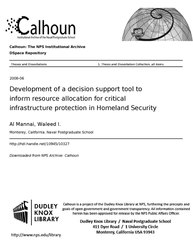File:Development of a decision support tool to inform resource allocation for critical infrastructure protection in Homeland Security (IA developmentofdec1094510327).pdf

Original file (1,275 × 1,650 pixels, file size: 1.15 MB, MIME type: application/pdf, 102 pages)
Captions
Captions
Summary[edit]
| Development of a decision support tool to inform resource allocation for critical infrastructure protection in Homeland Security
( |
||
|---|---|---|
| Author |
Al Mannai, Waleed I. |
|
| Title |
Development of a decision support tool to inform resource allocation for critical infrastructure protection in Homeland Security |
|
| Publisher |
Monterey, California. Naval Postgraduate School |
|
| Description |
Analysis of risk in critical infrastructure is one of the major problems facing Homeland Security today. Defining risk and applying it to systems, as opposed to individual assets, is a relatively new idea in Homeland Security policy. Thus, there is a need for a decision support tool to inform decision makers in Homeland Security of resource allocation strategies to harden assets that reduce overall network risk. Model Based Risk Assessment (MBRA) is a quantitative method designed to (1) identify the most critical assets of the network in such a way as to reduce expected loss over the entire network, (2) quantify allocation strategies that strategic planners and risk managers can apply across multi-sector systems, and (3) compute vulnerability and total risk reduction of the network. We formalized the definition of network risk in terms of the connectivity of the network as an extension to the accepted risk equation R=f(T,V,C). We use node degree as a heuristic for criticality of an asset to the overall function of the network. We then modeled the relationship between budget and vulnerability reduction and show how an exponential reduction model compares to a linear or random model. Using the stated definition of network risk, all models rank order assets exactly the same but they reduce risk differently. Lastly, we introduce a twoparty model that combines both the defender's and attacker's points of view using a game theory approach. We show the results of this model and compare them to a similar model we refer to as the \"arms race model\" where we allow both attacker and defender to know each other's budget. Results show that the techniques developed here are useful in conducting a systematic and repeatable analysis of an infrastructure network of assets for risk and then informing resource allocations that serve to reduce risk on the entire network, not just the selected assets. Subjects: Infrastructure (Economics); Risk assessment; Vulnerability of infrastructure analysis and risk assessment; allocation distribution; risk problems; critical infrastructure protection; defender-attack model; defender- only model; independent-objective and joint-objective functions |
|
| Language | English | |
| Publication date | June 2008 | |
| Current location |
IA Collections: navalpostgraduateschoollibrary; fedlink |
|
| Accession number |
developmentofdec1094510327 |
|
| Source | ||
| Permission (Reusing this file) |
Approved for public release, distribution unlimited | |
Licensing[edit]
| Public domainPublic domainfalsefalse |
This work is in the public domain in the United States because it is a work prepared by an officer or employee of the United States Government as part of that person’s official duties under the terms of Title 17, Chapter 1, Section 105 of the US Code.
Note: This only applies to original works of the Federal Government and not to the work of any individual U.S. state, territory, commonwealth, county, municipality, or any other subdivision. This template also does not apply to postage stamp designs published by the United States Postal Service since 1978. (See § 313.6(C)(1) of Compendium of U.S. Copyright Office Practices). It also does not apply to certain US coins; see The US Mint Terms of Use.
|
 | |
| This file has been identified as being free of known restrictions under copyright law, including all related and neighboring rights. | ||
https://creativecommons.org/publicdomain/mark/1.0/PDMCreative Commons Public Domain Mark 1.0falsefalse
File history
Click on a date/time to view the file as it appeared at that time.
| Date/Time | Thumbnail | Dimensions | User | Comment | |
|---|---|---|---|---|---|
| current | 09:10, 17 July 2020 |  | 1,275 × 1,650, 102 pages (1.15 MB) | Fæ (talk | contribs) | FEDLINK - United States Federal Collection developmentofdec1094510327 (User talk:Fæ/IA books#Fork8) (batch 1993-2020 #13785) |
You cannot overwrite this file.
File usage on Commons
The following page uses this file:
Metadata
This file contains additional information such as Exif metadata which may have been added by the digital camera, scanner, or software program used to create or digitize it. If the file has been modified from its original state, some details such as the timestamp may not fully reflect those of the original file. The timestamp is only as accurate as the clock in the camera, and it may be completely wrong.
| Short title | Development of a decision support tool to inform resource allocation for critical infrastructure protection in Homeland Security |
|---|---|
| Author | Al Mannai, Waleed I. |
| Software used | Al Mannai, Waleed I. |
| Conversion program | Acrobat Distiller 8.0.0 (Windows) |
| Encrypted | no |
| Page size | 612 x 792 pts (letter) |
| Version of PDF format | 1.4 |

